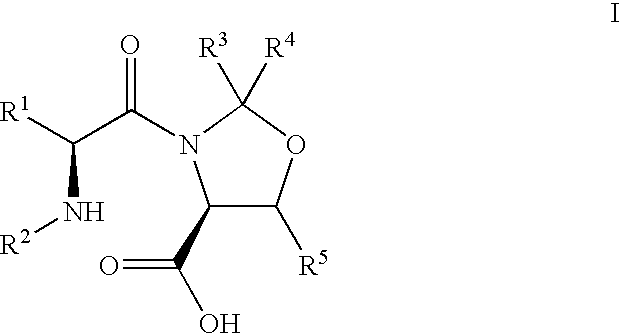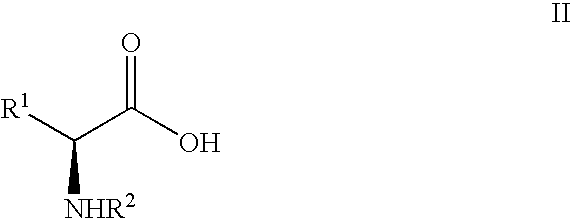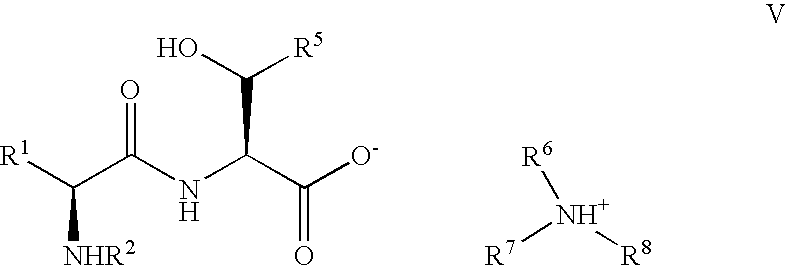Pseudoproline dipeptides
a technology of pseudoproline and dipeptides, which is applied in the field of new process for the manufacture of pseudoproline dipeptide compounds, can solve the problems of needing purification and less suitable synthesis for application on a technical or commercial scal
- Summary
- Abstract
- Description
- Claims
- Application Information
AI Technical Summary
Benefits of technology
Problems solved by technology
Method used
Image
Examples
example 1
[0077]A solution of 16.1 g N-hydroxysuccinimide and 40.0 g Fmoc-L-Ser(tBu)-OH in 200 mL of THF was added at 20° C. within 30 to 60 minutes to a suspension of 26.0 g 1-(3-Dimethylaminopropyl)-3-ethylcarbodiimide hydrochloride in 80 mL DMF and 80 mL THF. The resulting mixture was stirred at ambient temperature for 4 hours and then added within 30 to 45 minutes to a pre-cooled (−5° C.) suspension of 8.75 g lithium hydroxide monohydrate, 6.1 g lithium carbonate and 33.2 g L-Serine in 240 g of water. The resulting mixture was allowed to warm to room temperature within 30 minutes and then stirred at this temperature for another hour. The mixture was then cooled to −5° C. and the pH was adjusted from 8.5 to 2.0-2.5 with approx. 150 g of sulfuric acid (20% in water). The biphasic mixture was allowed to warm to room temperature and the lower aqueous layer was then separated. The aqueous layer was extracted with 200 mL of toluene. The combined organic layers were diluted with 150 mL of toluen...
example 2
[0078]A solution of 16.1 g N-hydroxysuccinimide and 40.0 g Fmoc-L-Ser(tBu)-OH in 200 mL of THF was added at 20° C. within 30 to 60 minutes to a suspension of 26.0 g 1-(3-Dimethylaminopropyl)-3-ethylcarbodiimide hydrochloride in 80 mL DMF and 80 mL THF. The resulting mixture was stirred at ambient temperature for 4 hours and then added within 30 to 60 minutes to a pre-cooled (−5° C.) suspension of 8.75 g lithium hydroxide monohydrate, 6.1 g lithium carbonate and 33.2 g L-Serine in 270 g of water. The resulting mixture was allowed to warm to room temperature within 30 minutes and then stirred at this temperature for another hour. The mixture was then cooled to −5° C. and the pH was adjusted to 2.5 with 137 g of sulfuric acid (20% in water). The biphasic mixture was allowed to warm to room temperature and the lower aqueous layer was then separated. The aqueous layer was extracted with 210 mL of toluene. The combined organic layers were diluted with 100 mL of toluene and then washed wit...
PUM
| Property | Measurement | Unit |
|---|---|---|
| temperature | aaaaa | aaaaa |
| temperature | aaaaa | aaaaa |
| temperature | aaaaa | aaaaa |
Abstract
Description
Claims
Application Information
 Login to View More
Login to View More - R&D
- Intellectual Property
- Life Sciences
- Materials
- Tech Scout
- Unparalleled Data Quality
- Higher Quality Content
- 60% Fewer Hallucinations
Browse by: Latest US Patents, China's latest patents, Technical Efficacy Thesaurus, Application Domain, Technology Topic, Popular Technical Reports.
© 2025 PatSnap. All rights reserved.Legal|Privacy policy|Modern Slavery Act Transparency Statement|Sitemap|About US| Contact US: help@patsnap.com



